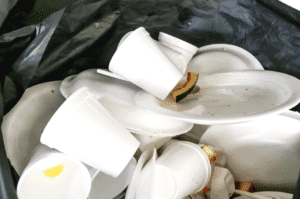In Metro Vancouver, about 10,500 tons of styrofoam is disposed of in landfills each year. Until 2019, only 21% of those styrofoam is recycled. The staggering amount of styrofoam entering landfills as single-use items has prompted Metro Vancouver to ban the landfilling of them in 2018. Last year, a surcharge was placed on all styrofoam loads taken to transfer stations, encouraging businesses and residents to find a sustainable alternative to styrofoam disposal.
The Next Step: Styrofoam Recycling
Styrofoam recycling quickly became the appealing alternative for Metro Vancouver residents and businesses. Many started dropping off styrofoam (EPS) at recycling depots, who receive these items free of charge. And yet, misconceptions around styrofoam recycling are still increasing recycling contamination rates. In fact, styrofoam is commonly tossed away with recyclables at home, which is wrong. Styrofoam containers can’t be placed in blue bins at home and taken out with regular garbage. Instead, styrofoam can be taken to the following places for recycling:
- London Drugs
- Return-It Depot on Powell Street
- Growing City
- Go-Green Bottle Depot and Recycling
- North Shore Bottle Depot
You may be wondering – what makes styrofoam different?
Styrofoam – Expanded Polystyrene
Commonly used by businesses, styrofoam is a durable and light-weighted material chosen often because of its ability to insulate and protect packaging during shipments. Styrofoam we know of takes form this way, but also as the take-out containers you regularly see at restaurants and food courts. But they have used styrofoam for many other industries in BC, such as the film industry. The film industry often uses styrofoam to create stage props, which are discarded in landfills once used. One thing about styrofoam is certain – it’s made prolific for being a cheaper alternative to other insulation, packaging, or prop-making material.
Challenges of Recycling Styrofoam
In the past, landfills have always been the dumping ground of styrofoam. Styrofoam would take decades to decompose. Now, styrofoam is recycled, but with recycling comes new challenges. Food and oil can contaminate styrofoam, making them very difficult to clean and recycle. Styrofoam parts may also break off, leaving microplastics that are lost. Finally, rules around recycling styrofoam can confuse residents and businesses, who rarely have the time to memorize recycling processes for all materials they encounter.
Challenge #1: Confusing rules around styrofoam recycling
Old habits die hard – and that’s the case with styrofoam recycling. But it’s much more complex than that. In fact, the average resident may be bombarded with many recycling practices for all the items they have at home. Finding the right recycler can be time-consuming and exhausting. To complicate matters, recycling policies can differ city to city. In Metro Vancouver, styrofoam does not belong in the blue recycling bins. Instead, you must take it to a depot that accepts the material. But if you have never been exposed to these practices, it can get very confusing very fast.
Challenge #2: Food and grease contamination
Grease-covered styrofoam containers cannot be recycled effectively. Unlike other food container materials such as cardboard, food and grease seep into the styrofoam pores, making it difficult for recycling. Rinsing the styrofoam out is one option, but it may not be effective. While food-soiled cardboard boxes (such as pizza boxes) can be dumped in your organics bin, the same cannot be said for food-soiled styrofoam containers.
Challenge #3: Inaccessible recyclers
Even if you want to recycle styrofoam, do you even know where to begin? Do you even know where you should take them? Recycling depots that take styrofoam can be far and few in between, or those that accept styrofoam may have separate rules. Or, they may simply be too far out of reach — making styrofoam recycling inaccessible.
Reasons to Recycle Styrofoam
Although styrofoam recycling is a challenge, it is still worth recycling. Think of all the single-use styrofoam plates and cups thrown away daily. Think about the EPS sheets piling up in landfills by the truck. And now with the convenience of online shopping, styrofoam will continue to sneak into the packaging and into our waste streams.
Reason #1: Styrofoam is not biodegradable.
Reason #2: Styrofoam litter in public places is harmful for wildlife.
Reason #3: Styrofoam is lightweight and easily carried by wind or water.
Reason #4: Styrene, a chemical component of styrofoam, can seep into the food we store.
Alternatives to Styrofoam Use
In 2020, styrofoam use will dwindle across Metro Vancouver as they put new bans in place. Single-use styrofoam will quickly phase out as more sustainable food storage containers, insulation, and packaging material arrive on the market. There are already other alternatives too, that would reduce one’s environmental impact. Some restaurants have already shifted to biodegradable take-out containers, and others have encouraged patrons to bring their own containers for take-out. Companies are investing in sustainable packaging and reusing package materials.
What Else You Can Do
The easiest way to deal with waste is to not create it. It may not be possible for other items we use on a daily basis, but we can with styrofoam. We can all do our part in limiting our use of styrofoam since so much of it is single-use. Simply by packing a lunch box or a reusable bottle can limit the temptation of using styrofoam for take-out. Hosting parties and work functions with reusable utensils can be more sustainable than using single-use styrofoam items. Ship items using newsprint or cloth padding instead of styrofoam peanuts can also be helpful.
Canadian Mattress Recycling Inc. Since 2011, Canadian Mattress Recycling has recycled over 25 million pounds of mattresses and furniture at their recycling facility. Every day, commercial businesses and residents drop off their mattresses for recycling, or book a pickup for a crew to take their items away. As a company that cares about the community and the environment, you’ll see us blogging about recycling throughout the year. Want to read more, or want to stay in touch? Like us on Twitter and Facebook.


